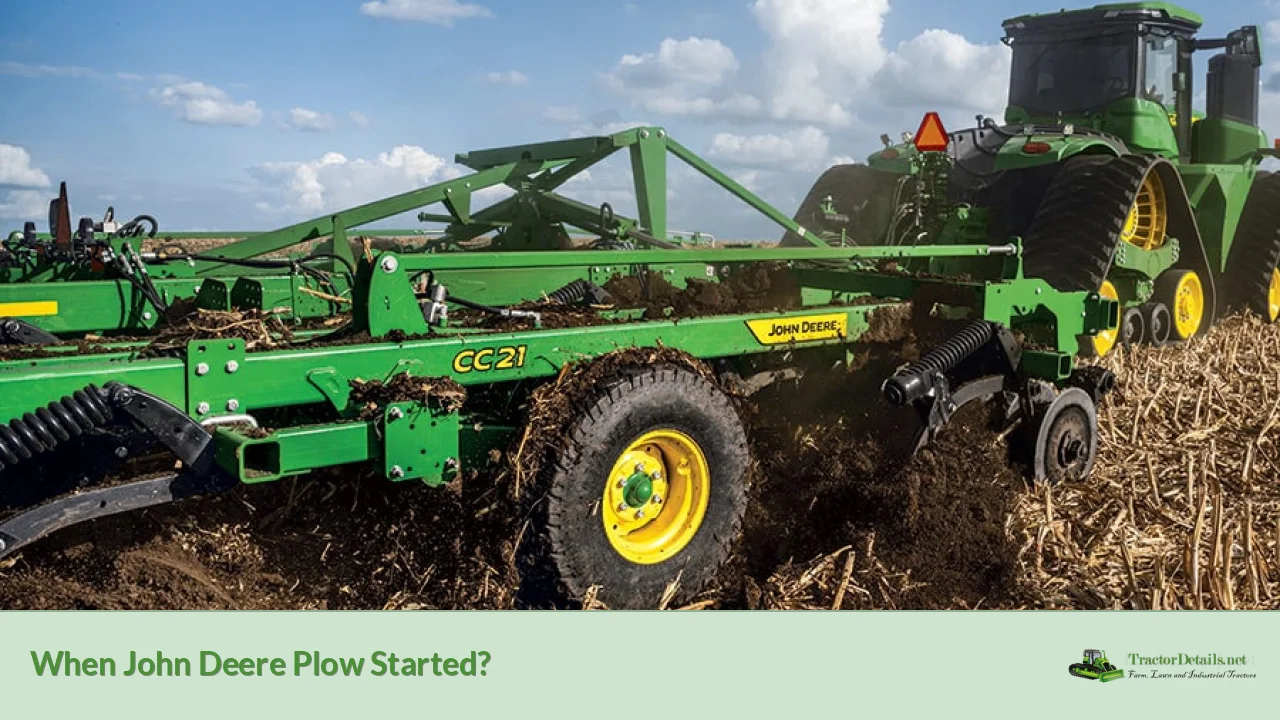In 1837, John Deere revolutionized agriculture with the invention of the self-scouring steel plow. This innovative tool addressed the challenges faced by farmers in the Midwest, particularly those dealing with the heavy, sticky soil of the prairie. Prior to this invention, farmers struggled with cast-iron plows that often clogged and required frequent cleaning. Deere's design allowed soil to slide off easily, greatly improving efficiency and productivity for farmers.
Deere crafted his first plow using a broken steel sawmill blade, which he shaped into a moldboard that could effectively cut through tough soil. His approach marked a significant departure from traditional wooden and cast-iron plows, making it possible for settlers to cultivate land more effectively. By 1846, Deere was producing nearly 1,000 plows annually, and his business continued to grow as he relocated to Moline, Illinois, where he could access better resources and transportation.
| Year | Plows Produced |
|---|---|
| 1837 | 1 |
| 1838 | 2 |
| 1839 | 10 |
| 1840 | 40 |
| 1841 | 75 |
| 1842 | 100 |
| 1843 | 400 |
| 1857 | 10,000 |
The Impact of the John Deere Plow
The introduction of the steel plow had profound effects on American agriculture. It enabled farmers to cultivate larger areas of land more efficiently, which was crucial during the westward expansion of the United States. As settlers moved into the Midwest, they faced unique agricultural challenges that required innovative solutions. The self-scouring feature of Deere's plow meant that farmers could work longer without interruption.
By using highly polished steel for the moldboard, Deere's design minimized soil adhesion. This was particularly beneficial in regions where traditional plows would become bogged down by wet or heavy soil. As a result, Deere's plow became a symbol of progress in agricultural technology and was instrumental in transforming farming practices across America.
The demand for Deere's plows skyrocketed as word spread about their effectiveness. By the early 1850s, Deere's factory was producing thousands of plows each year. This rapid growth not only established John Deere as a leading manufacturer but also contributed significantly to the agricultural economy of the time.
Evolution of Plow Design
Over the years, John Deere continued to innovate and improve upon his original design. He experimented with different materials and manufacturing techniques to enhance the performance of his plows. By moving his operations to Moline in 1848, Deere gained access to better resources and transportation routes, which facilitated increased production.
In addition to enhancing efficiency, Deere also diversified his product line. He began producing various models tailored to different farming needs, including riding plows and corn planters. This adaptability helped solidify John Deere's reputation as a pioneer in agricultural machinery.
The company’s commitment to innovation did not stop with the original steel plow; it extended into many other agricultural implements and machinery that would follow. The legacy of John Deere's ingenuity is evident today in the wide range of equipment available for modern farming.
The Legacy of John Deere
John Deere's contributions to agriculture extend far beyond his initial invention of the steel plow. The company he founded has become synonymous with farming equipment worldwide. Today, John Deere manufactures a comprehensive array of machinery that supports various agricultural practices.
The impact of Deere's work is recognized not only in practical terms but also culturally; his steel plow is considered one of the tools that helped shape America. The Smithsonian Institution includes one of his early models in its collection as part of its "101 Objects That Made America" exhibit.
Even today, as farming techniques evolve towards more sustainable practices such as no-till farming, John Deere remains at the forefront by adapting its product lines to meet changing needs. The company continues to innovate with advanced technologies like precision agriculture tools that help farmers optimize their yields while minimizing environmental impact.
Challenges and Changes in Agriculture
As agriculture has progressed over the years, so have the challenges associated with it. Modern farming practices are increasingly influenced by environmental concerns and technological advances. The rise of no-till farming has shifted focus away from traditional moldboard plowing methods toward techniques that preserve soil structure and reduce erosion.
In response to these changes, John Deere has adapted its offerings by developing new types of tillage equipment that align with current agricultural practices. This evolution reflects a broader trend in agriculture where sustainability is becoming paramount.
Despite these shifts, John Deere's foundational principles remain intact: innovation and quality are at the heart of what they do. As they phase out older models like the traditional moldboard plow, they continue to invest in research and development to meet modern agricultural needs.
FAQs About When John Deere Plow Started
- What year did John Deere invent his first plow?
The first John Deere plow was invented in 1837. - How did John Deere's plow differ from previous designs?
Deere's plow featured a self-scouring steel moldboard that prevented soil from sticking. - What impact did the steel plow have on farming?
The steel plow allowed farmers to cultivate land more efficiently and effectively. - Where was John Deere's first factory located?
The first factory was located in Grand Detour, Illinois. - Is John Deere still manufacturing plows today?
No, recent changes in farming practices have led to discontinuation of traditional moldboard plows.
John Deere's journey from blacksmithing to pioneering agricultural innovation is a testament to how one man's vision can transform an industry. His legacy lives on through modern farming practices and advanced machinery that continue to shape agriculture today.
